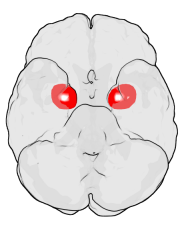
Photo from wikipedia
Abstract Time-dependent variability in mood and anxiety suggest that related neural phenotypes, such as threat-related amygdala reactivity, may also follow a diurnal pattern. Here, using data from 1,043 young adult… Click to show full abstract
Abstract Time-dependent variability in mood and anxiety suggest that related neural phenotypes, such as threat-related amygdala reactivity, may also follow a diurnal pattern. Here, using data from 1,043 young adult volunteers, we found that threat-related amygdala reactivity was negatively coupled with time of day, an effect which was stronger in the left hemisphere (β = −0.1083, p-fdr = 0.0012). This effect was moderated by subjective sleep quality (β = −0.0715, p-fdr = 0.0387); participants who reported average and poor sleep quality had relatively increased left amygdala reactivity in the morning. Bootstrapped simulations suggest that similar cross-sectional samples with at least 300 participants would be able to detect associations between amygdala reactivity and time of scan. In control analyses, we found no associations between time and V1 activation. Our results provide initial evidence that threat-related amygdala reactivity may vary diurnally, and that this effect is potentiated among individuals with average to low sleep quality. More broadly, our results suggest that considering time of scan in study design or modeling time of scan in analyses, as well as collecting additional measures of circadian variation, may be useful for understanding threat-related neural phenotypes and their associations with behavior, such as fear conditioning, mood and anxiety symptoms, and related phenotypes.
Journal Title: Social Cognitive and Affective Neuroscience
Year Published: 2017
Link to full text (if available)
Share on Social Media: Sign Up to like & get
recommendations!